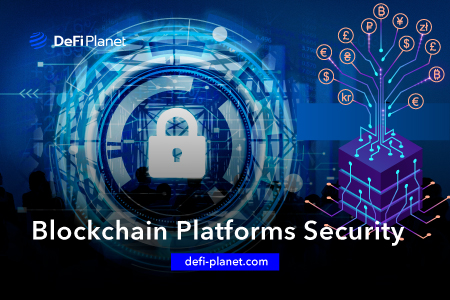Introduction
A blockchain is a distributed database that is shared across computer network nodes. It is a database that electronically saves information in digital format. The information is accessible to all specified nodes or members, who can record, distribute, and examine encrypted transactional data on their blockchain.
This data is kept in “blocks,” each of which can hold a specific quantity of data. When a block reaches its maximum capacity, it is attached to the preceding full block, forming a data chain known as a ‘blockchain.’
Each new block of information is linked to all preceding blocks in such a way that tampering with the information is practically impossible. A consensus process validates and agrees on all transactions in the block, ensuring that each transaction is correct.
Basics of blockchain security
Blockchain is designed in such a way that it allows for minimum trust among individuals. Blockchain security refers to the risk management system for networks and methods for mitigating risks related to fraud and cyber-attacks.
Blockchain technologies are fundamentally secure as they are based on consensus, cryptography, and decentralisation.
However, this does not guarantee that the technology is 100% secure. It is still prone to cybercrimes and manipulations that can cause damage.
The different types of security by blockchain types
Blockchain networks can be public or private, depending on who can participate and who has access to the data.
Public blockchains: are permissionless blockchain networks. They typically can be joined by anyone. The system is decentralised and does not have any authoritative entity. In such a blockchain, transactions are validated through consensus by internet-connected computers. Bitcoin and Ethereum are well-known examples of public blockchains and both achieve consensus through mining. Miners perform a complicated cryptographic task and validate the transaction (proof of work). This type of network has few identifications and access constraints.
Private blockchains: are also known as permissioned blockchains because they use identity to confirm membership and access privileges. Only one organisation has control over the network i.e., forming a private, members-only network. The network achieves consensus by selective endorsement, in which only recognised users check transactions. Members with specific access and authorization can maintain the transaction ledger.
Private and permissioned networks are ideal for compliance and regulatory reasons. Public and permissionless networks, on the other hand, enable more decentralisation and dissemination. Hence, it is crucial to determine the type of blockchain that meets your specific business needs.
Some popular blockchain cyberattacks and scams
- DAO Code Exploitation: This event exposed privacy and security vulnerabilities with the Decentralised Autonomous Organisation (or DAO) blockchain. While programmers were resolving a problem with code malfunctioning on the system, an unknown attacker started draining the DAO of Ether acquired from the sale of its tokens. More than $60 million in Ether was stolen in just a few hours, and the loss was especially distressing for DAO because it amounted to more than one-third of its overall value. The primary reason for this incident was code exploitation, demonstrating the vulnerability of the blockchain infrastructure.
- Missing Keys: There have been cases of bitcoin theft, the most notable of which occurred at Bitfinex, a Hong Kong-based cryptocurrency exchange.
The total amount stolen was close to $72 million. The most likely cause of the theft, according to investigative reports, was either stolen private keys or personal digital signatures.
- Hacking Employee System: Another notable example of blockchain security vulnerabilities is the hack of Bithumb, one of South Korea’s largest cryptocurrency exchanges for Bitcoin and Ethereum. During this incident, hackers gained access to the data of around 30,000 users while also stealing $32 million in Bitcoin. Surprisingly, the core systems were not compromised, and the main culprit was a hacked employee PC. Essentially, an attacker gained access to a network node, and internal security procedures were not effectively deployed, resulting in a costly mistake for the firm.
Methods used by fraudsters to attack blockchain technologies
- Routing attacks: These attacks can be used to partition the segment into two or more disjoints. This prevents nodes from connecting with other nodes outside the network. Hackers can intercept data as it travels to the Internet Service Providers (ISPs) and force the creation of parallel blockchains.
- 51% attacks: Also referred to as a majority attack. As the name implies, majority attacks occur when a single individual or group acquires 50% of a blockchain network’s mining hash rate. If the attack is successful, attackers will possess a majority of network control, allowing them to reorder new transactions and prevent them from being completed. This can potentially cause double-spending problems.
- Sybil attacks: A Sybil attack occurs when a single node actively operates multiple identities simultaneously, depleting the network’s power. The primary purpose of this attack is to seize control of the majority of network influence. This allows the execution of fraudulent activities in the system.
- Phishing attacks: In this case, the hacker sends an email that directs recipients to a website that requests their private key information. The hacker can steal the cryptocurrencies in the wallet after obtaining the necessary information. These are the most common types of cyberattacks.
What’s needed for a secure blockchain solution?
Consider the following factors while creating a safe and secure blockchain:
When constructing a blockchain, it is important to consider the governance model for the participating members as well as the type of data that will be collected in each block. This would aid in the evaluation of risks in business and governance, leading to the development of a risk model.
It is critical to understand the relevant legislative requirements as well as the basic security posture for participation before evaluating the vulnerabilities that comprise a threat model.
Finally, security protocols must be developed to limit risks and threats, therefore safeguarding the blockchain solution as well as the logic for resolving blockchain collisions.
Blockchain security tips and best practises
- The blockchain solution’s underlying infrastructure should be considered as vital infrastructure to ensure that the relevant security measures are in place.
- Use best practises for network partitioning both within and outside the network, as well as within the enterprise, to limit access. To host digital assets for all platform members, the solution must be partitioned utilising channels and namespacing. Namespacing enables it to manage who has access to the digital assets hosted on the platform and, if done correctly and on time, can help save costs.
- Define and enforce proper endorsement policies based on business contracts. These policies must be governed by a smart contract to ensure the security of the corporate network. These regulations should, as a best practise, be scoped and defined at both the namespace and ledger key levels. The blockchain solution uses these policies to determine the parameters that must be met in order to authenticate the legitimacy of a submitted transaction.
- To manage access to the blockchain solution and data, identity and access limits should be imposed. This would guarantee that the appropriate degree of access is granted to the appropriate individual. The off-boarding procedure should also be described in order to prevent information exfiltration. Audit logs and access mechanisms must be implemented to notify the operations team of any harmful behaviour so that it can be mitigated.
- If the company utilises its own IAM system and acts as an identity provider (IDP), relevant tokens such as OAUTH, OIDC, and SAML2 should be used to provide authentication, verification, and authorisation. The consortium members’ status as IDPs or service providers (SPs) should be determined early on.
- Use an HSM (Hardware Security Module) to safeguard the blockchain identity keys, and ensure that each organisation has its own partition in the HSM where the keys are stored. Using an HSM to store the blockchain identity keys ensures the security of the keys. The partitioning procedure ensures that each organisation has its own partition with its own admin privileges and roles for partition activities.
- For administrative or change management purposes, use a PAM (Privileged Access Management) solution to verify that only users with the appropriate permissions have access to the components. This is especially important given that the platform may contain sensitive information such as payment transactional data for users and members.
- API security best practises should be followed to protect API-based transactions. APIs are the primary means of communication between the many components of a blockchain solution. APIs must be protected against unauthorised use and limited to the scope of the transaction.
- Use a secret store to gain application and privileged access. A variety of components of blockchain technology interact with both user- and API-based transactions. Some of these transactions are dependent on fixed keys such as passwords, tokens, or certificates. These keys must be kept in a private store, and access to them at runtime must be restricted based on usage.
- Use a data categorization strategy to protect data/information. It is vital to identify and categorise data linked with commercial, legal, and technological sectors in order to implement appropriate information security policies to protect data and ensure privacy.
- To secure data, use DevOps to automate application vulnerability scanning during the development lifecycle. According to the data categorization analysis, data security must be implemented at several levels, including application and database.
- Trusted Platform Modules (TPMs) should be utilised for sensitive code execution. Certain solution components are more important than others, and implementing trusted platform modules in these critical components helps with cryptographic content storage. They also enable the execution of a privacy-preserving chaincode that detects tampering by the node’s administrator.
Conclusion
There is no such thing as a perfectly secure cyber defence or information system. What is deemed safe now will not be safe in the future, because cybercrime is a profit-making enterprise, and the resourcefulness of criminals in devising new means of attack is unparalleled. Despite the fact that certain blockchains incorporate underlying features that ensure data confidentiality, integrity, and availability, cyber security controls and standards are essential for organisations using blockchains to defend themselves against external threats.
If you would like to read more news like this, visit our Website. You can also follow DeFi Planet on Twitter, Facebook, Instagram, and LinkedIn.





















